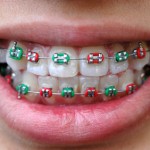
This is the latest update of a Cochrane review which aims to assess the effects of initial arch wires for alignment of teeth with fixed orthodontic braces in relation to alignment speed, root resorption and pain intensity.
The Cochrane Oral Health Group’s Trials Register, CENTRAL, Medline and Embase databases were searched. Handsearching of a number of orthodontic journals was also undertaken. Orthodontic and IADR conference abstracts were searched along with the reference lists of identified studies. There were no restrictions with regard to publication status or language of publication. Only randomised controlled trials involving fixed appliance therapy were included. Standard Cochrane methodological approaches were used.
- 9 studies (571 participants) were included.
- All trials were at high risk of bias.
- None of the trials reported the important adverse outcome of root resorption.
- 4 trials compared Multistrand stainless steel initial arch wires compared to superelastic nickel titanium (NiTi) initial arch wires. Because of difference comparisons and outcomes no meta-analysis was possible. There was insufficient evidence to identify differences in either rate of alignment or pain between stainless steel and NiTi initial arch wires.
- 2 trials compared conventional (stabilised) NiTi initial arch wires compared to superelastic NiTi initial arch wires. There was insufficient evidence to identify differences between the two.
- 3 trials compared single-strand superelastic NiTi initial arch wires compared to other NiTi (coaxial, copper NiTi (CuNiTi) or thermoelastic) initial arch wires. There is very weak unreliable evidence, based on one very small study (n = 24) at high risk of bias, that coaxial superelastic NiTi may produce greater tooth movement over 12 weeks, but no information on associated pain or root resorption. This result should be interpreted with caution until further research evidence is available. There is insufficient evidence to determine whether or not there is a difference between either thermoelastic or CuNiTi and superelastic NiTi initial arch wires.
The authors concluded
There is no reliable evidence from the trials included in this review that any specific initial arch wire material is better or worse than another with regard to speed of alignment or pain. There is no evidence at all about the effect of initial arch wire materials on the important adverse effect of root resorption. Further well-designed and conducted, adequately-powered, RCTs are required to determine whether the performance of initial arch wire materials as demonstrated in the laboratory, makes a clinically important difference to the alignment of teeth in the initial stage of orthodontic treatment in patients.
Links
Jian F, Lai W, Furness S, McIntyre GT, Millett DT, Hickman J, Wang Y. Initial arch wires for tooth alignment during orthodontic treatment with fixed appliances. Cochrane Database of Systematic Reviews 2013, Issue 4. Art. No.: CD007859. DOI: 10.1002/14651858.CD007859.pub3.
